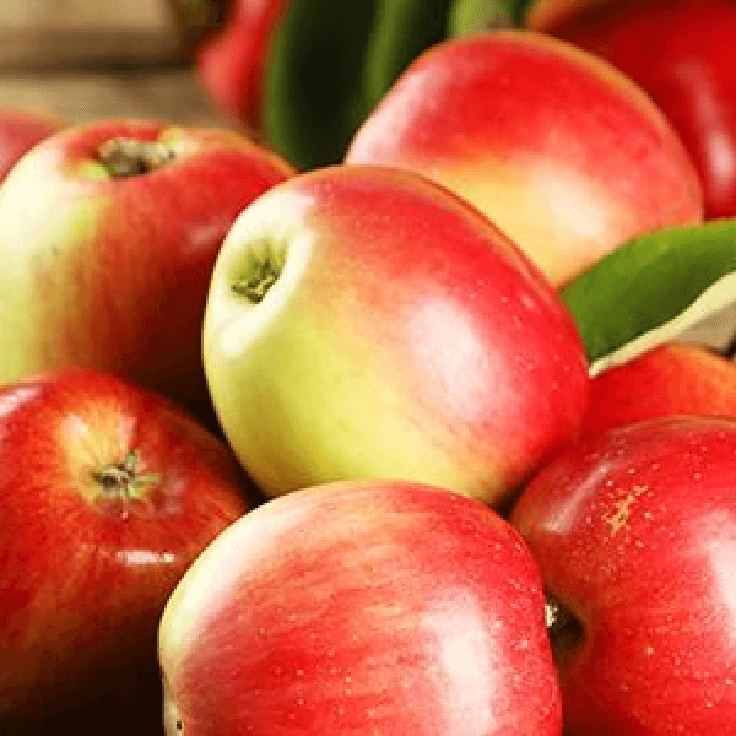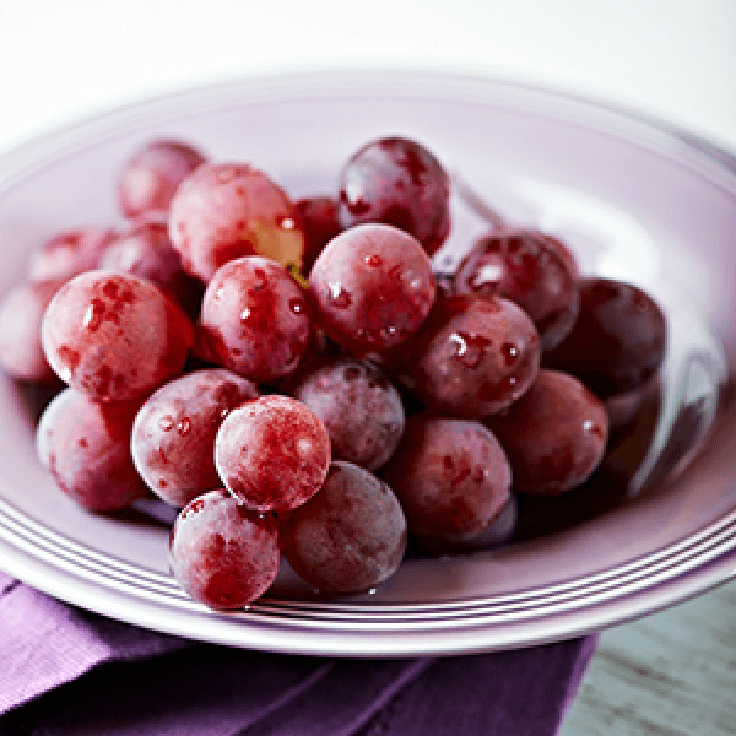- Strawberries
- Cook With Apples
- Grapes
- Grapefruit
- Lemons
- Cabbage
- Asparagus
- All About Bulb Vegetables
- All About Cruciferous Vegetables
- Squash
- All About Root Vegetables
- The Gift of Spice
- Thyme
- Basil
- Raspberries
- All About Tuber Vegetables
- Marjoram / Oregano
- Lemongrass / Citronella
- All Our Fruits, Vegetables and Fresh Herbs
- All About Exotic Fruits
- All About Legumes
- Cooking Pears: Three Inspirational Methods
All About Exotic Fruits

Never before have consumers had so much choice when it comes to exotic fruit.
Exotic fruit generally don’t travel very well. But new refrigeration techniques and modes of transportation have led to a plethora of tasty varieties being on grocery shelves year-round.
Batata

Batatas (aka Cuban sweet potatoes or boniatos) are a type of sweet potato native to tropical America . They have a white or yellowish flesh with a reddish, orange skin. Even if batatas are starchier than orange-flesh sweet potatoes, you can use them anytime a recipe calls for one.
In fact, small batatas have a richer flavour and keep their firmness once cooked, making them perfect for a range of dishes, from appetizers to desserts! Batatas can be kept in a cool area (about 13 ºC) for about a week. They are a source of vitamins B6 and C.
Cactus pear / Barberry fig / Fruit of Sharon
Cactus fruit (or prickly pears) are egg-shaped fruits measuring about 8 to 10 cm in length. The orange, reddish flesh is juicy, slightly tart, sweet, fragrant, and contains edible seeds.
When shopping for a cactus fruit, pick one that’s firm and unblemished. Any signs of bruising may mean the flesh is too soft and unpleasant to eat. Cactus fruit are ripe when the skin yields to a soft squeeze. They are delicious in deserts, fruit salads, and pair well with vegetables, chicken, and shrimp. They can also be enjoyed with a spoon! Ripen at room temperature.
Cactus fruit are high in vitamin C, fibre, potassium, and magnesium.

Carambola

Carambolas are also known as star fruit. Originally native to Sri Lanka and the Maluku Islands, they are now grown around the globe in tropical and subtropical climates. Carambolas have a translucent flesh that is crispy, juicy, and tangy.
When shopping for a carambola, pick one that is firm, bright, unblemished, and smells fruity. When cooked, they pair well with Asian-style seafood dishes. They’re also delicious ingredient in marinades, jams, and jellies. Carambolas can also be eaten as is – simply slice one up and top with a drizzle of the vinaigrette of your choice.
If your carambola is green, leave it at room temperature for a few days until it’s turned yellow and fragrant. Carambolas are high in vitamin A, vitamin C, and potassium.
Cherimoya
Cherimoyas – aka custard apples – come from South America but are now grown in temperate climates in the south of Spain, Chili, Brazil, Israel, and Lebanon. Cherimoyas turn a deep purple as they ripen – this is when they’re the most delicious! They are sweet, creamy, very fragrant, and taste like a mix of strawberries and pineapple.
If you’re hankering for a one-of-a-kind tropical fruit salad, wash and peel a cherimoya, then toss with strawberries, raspberries, and papaya. Or if you want to enjoy as is, simply slice in half, grab a spoon, and scoop out the delicious flesh.
But keep in mind that cherimoyas don’t have a long shelf life! Cherimoyas are rich in vitamin C, iron, phosphorus. They also have a high sugar content.
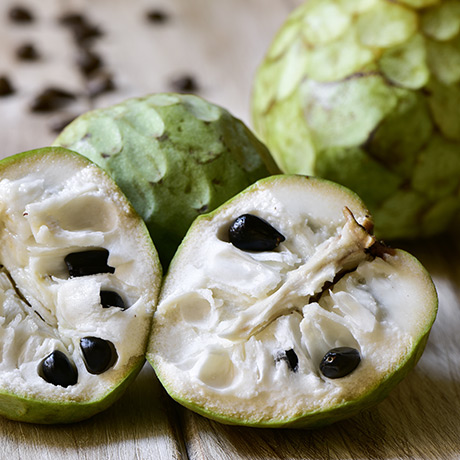
Fig
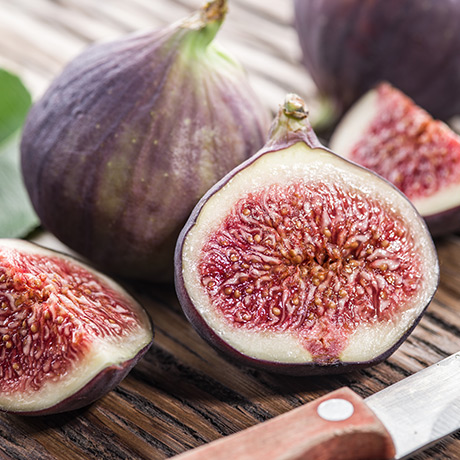
Figs are native to the Mediterranean region. Popular varieties include the Black Mission, Kadota, and Calimyrna which are grown in California are in season from June to November. Choose figs that are soft and plump but with a firm stem. Avoid figs that are squishy, bruised, mouldy, or smell sour.
Why are figs often sold dried? Because they have a very short shelf life. Figs are the perfect complement to dried fruit, cheese and charcuterie, ham, poultry, lamb, and duck. They’re also delicious in jams, compotes, and desserts. Enjoy them once they are ripe.
If they are too firm, simply store at room temperature until they ripen. Figs are rich in vitamins A, B, and C, and in potassium, magnesium, iron, copper, and fibre.
Guava
Originally grown in the Caribbean and Central America, guavas are kind of like a mix of a fig and a pear but with a white, pink, or red flesh. If you have a guava on your grocery list, pick one that’s not too ripe, too soft, or too firm.
Looking for inspiration when it comes to dishes that feature this delicious fruit? Enjoy them in a fruit salad, bake them in a pie, turn them into jams, jellies, compotes, or chutney, or add them to your favourite smoothie recipe. Or simply bite into them – skin and all! If you need to ripen your guava, store it at room temperature for three to four days. Guavas are an excellent source of vitamin C and potassium.
They also contain vitamin A, niacin, and traces of phosphorus and calcium.

Kiwi

Do kiwis the fruit have anything to do with Kiwis, aka New Zealanders? The fruit – which is called kiwifruit in New Zealand – was named because the fuzzy brown skin reminded them of the kiwi (the bird). In fact, gold (or yellow) kiwis, are a new variety grown in New Zealand. They are sweet, slightly tart, and have edible black seeds.
Even though most people prefer their kiwis without the skin, it is edible. When you’re at the store, pick a kiwi that doesn’t have any spots or mushy spots. Fun fact: kiwis can be used to tenderize meat! Place a few kiwi slices on top of your meat for about 20 to 30 minutes. And when it comes to fruit salads, kiwis are the undisputed champ. But only add them to your dish a few minutes before serving since they can soften other fruit.
Kiwis are an excellent source of vitamin A and are high in vitamin C – containing 25% more than the same weight of oranges! They’re also a source of potassium and magnesium. Moreover, studies have shown they may help with stress management.
Longan
Longans are closely related to lychees and rambutans. They grow in clusters of about 30 and tend to be yellow brownish to dark red in colour. They’re a spherical fruit with a translucent, juicy flesh that is very sweet. A longan is also known as a dragon’s eye because of the white eye-shaped mark on the otherwise large, shiny, black pit.
Pick a longan that is smooth and bright. To remove the shell, start by peeling a bit off near the tip and then peel the rest off. Longans are delicious as is or in fruit salads. You can also add them to rice dishes, vegetable stir-fries, in salads, or sauces.
Store your longans in the fridge in a perforated plastic bag with a paper towel to absorb excess moisture. Longans are high in vitamin C, potassium, and are a source of magnesium and copper.

Loquat

The loquat is a small, yellowish, fleshy, pear-shaped fruit. To enjoy its sweet flesh at its best, the fruit should be picked when fully ripe. If overripe, it may taste too sour.
The loquat is delicious in fruit salads, and its slightly sweet and tangy flavor makes it an excellent choice for pastries and jams. Its seeds contain hydrocyanic acid, which is highly toxic. This is why only the freshest seeds are used for planting. When stored at a temperature of 10°C and a humidity level of 90–95%, the loquat can be kept for up to two weeks.
The loquat is rich in calcium (16 mg) and vitamin A, while its skin contains a high concentration of tannins.
Lychee
Lychees have been grown in China and Vietnam for more than 2,000 years! They are an exotic stone fruit with a thin, tough rind covering smooth translucent flesh that is juicy, sweet, and fragrant. They taste a bit like roses and strawberries.
If you’re on the hunt for the perfect lychee, choose one that’s still attached to the stem with a pink to dark red rind. Lychees are delicious in rice and vegetable dishes and in stuffings and sauces. They also pair well with pork and duck.
You can keep them in the fridge for up to a week but store them in a plastic bag with a paper towel that will absorb any moisture. Lychees are rich in vitamin C and potassium. They’re also a source of copper and magnesium.
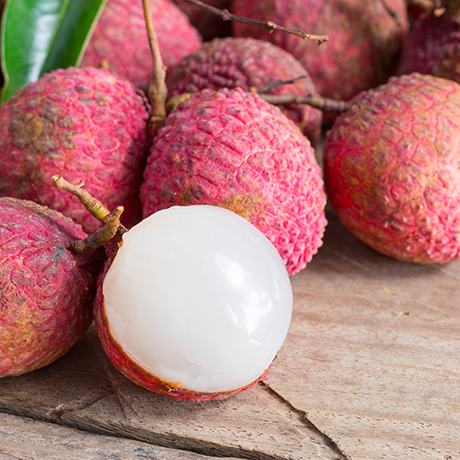
Mango

Mangos look a bit like giant peaches. Their flesh is orange, juicy, sweet, and fragrant. They have a lightly tangy and slightly spicy taste. Pick a mango that’s not too firm or too soft to the touch and one that is fragrant. Mangos are delicious as is, in fruit salads, and even cereal.
They’re also delicious in pies, jams, sorbets, cakes, and other desserts. They pair well with poultry, duck, pork, shrimp, and other seafood. If you need to ripen your mango, store it at room temperature for a few days.
Mangos are high in vitamin A and C and a good source of potassium and copper.
Papaya
Papayas were originally grown in Central America and are now popular around the world. Choose a papaya that doesn’t have any blemishes on its yellow orange skin and make sure it is slightly soft to the touch. Papayas are delicious with smoked meats, seafood platters, and chicken curry dishes.
They’re also perfect for fruit salads, puddings, yogurt and can be turned into jam, ketchup, and chutney. Want to ripen a papaya? Store it at room temperature until it turns fully yellow. To speed up the process, you can place it in a brown paper bag with an apple. Greenish papayas can be shredded like carrots or treated as a winter squash: bake or grill them.
They’re an excellent source of potassium, vitamin C, and vitamin A.

Passion fruit

Passion fruit are native to South America but are now grown in most countries with tropical climates. While the hard yellow or purple brownish rind is inedible, the soft pulp is sweet, juicy, tart, very fragrant, and full of edible seeds. Passion fruit are delicious eaten as is, with yogurt, or as an ice cream topping (and all kinds of other desserts!).
Because they are so fragrant, they’re an ideal ingredient in fruit salads and beverages of all kinds – including cocktails and punches. They can also be turned into jams, coulis, and sauces that are a perfect pairing for wild game. Passion fruit can be stored at room temperature until ripened.
They are an excellent source of vitamin A, vitamin C, potassium, and sodium. They are also rich in iron, magnesium, niacin, and phosphorus.
Persimmon
Persimmons, unsurprisingly, come from the persimmon tree. They have a soft texture and look a bit like tomatoes. Select one that’s bright, sleek, unblemished, and has a stalk that’s intact. Persimmons are so tasty, you can simply enjoy them with a spoon, with or without the skin. Feeling adventurous? Add a dash of dark rum! Persimmons are delicious pureed, as a coulis, as a jam, or in pies and cakes.
They are also a delicious ingredient in fruit salads, rice, and seafood dishes. And in some Asian countries, persimmons are turned into wine and liqueur.
Persimmons can be stored in the fridge for a few days. They’re high in vitamin A and are a source of potassium, vitamin C, and copper.
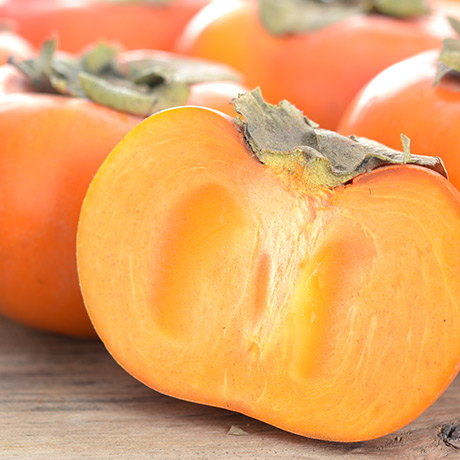
Pineapple

Pineapples are a mildly acidic, fragrant fruit with a yellow and brown rind. To pick a good pineapple, select one that smells fruity and feels hefty for its size. Make sure it doesn’t have any spots or mould growing on it. It must be firm yet have a bit of give when you squeeze.
Pineapples are excellent as is, in fruit salads, cakes, pies, punches, sorbets, ice cream, yogurt… and the list goes on and on! You can also slice and pan fry them with butter. This is a delicious side for ham (a traditional dish for Easter in Quebec) and white meat.
Pineapples are an excellent source of vitamin C, fibre, potassium, folic acid, and magnesium.
Pitaya
Pitayas – also known as a dragon fruit or strawberry pears – are native to Central America and have a mildly sweet flavour with a subtle aftertaste of milk. Pitaya flesh has been described as similar to the texture of a melon.
You can eat a fresh pitaya with a spoon. You can also add it to sorbet or a fruit salad. Once ripe, store in the fridge.
While they are low in calories (100 g of pitaya only contain about 50 calories), pitayas are high in vitamin C, fibre, minerals, antioxidants, and betacyanin (red pitaya).

Plantain
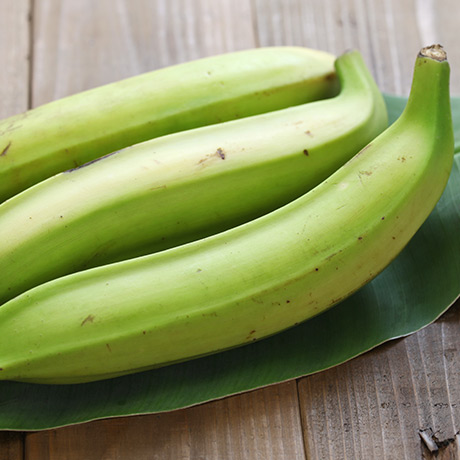
Plantains are grown in South America, the Caribbean, and Africa. Plantains have a green peel that is thicker than typical yellow bananas and flesh that is firm, slightly pink, and very starchy. Plantains are not as sweet as yellow bananas.
When picking a plantain, choose one that’s firm and unblemished. Keep in mind that a brown or dark peel doesn’t mean the flesh isn’t good. Plantains can be kept at room temperature for 7 to 10 days but don’t put them in the fridge unless they are very ripe. You can also freeze plantains: simply peel and wrap them individually.
Plantains are rich in potassium and an excellent source of vitamin C, vitamin B6, and magnesium. They also contain vitamin A and folic acid.
Rambutan
Rambutans are an oval-shaped fruit covered in soft spikes that were originally grown in Indonesia and Malasia. They kind of look like a sea urchin and have a juicy, translucent white flesh. Make sure the rambutan you pick is bright red with green spikes.
You can then peel it and serve with ice cream (we recommend coffee ice cream!). Rambutans are related to leechees and longans, so toss all three varieties together with crab and avocado for a quick, delectable meal.
Good to know: rambutans don’t have a long shelf life so enjoy quickly. They are high in vitamin C, iron, potassium.

Red banana
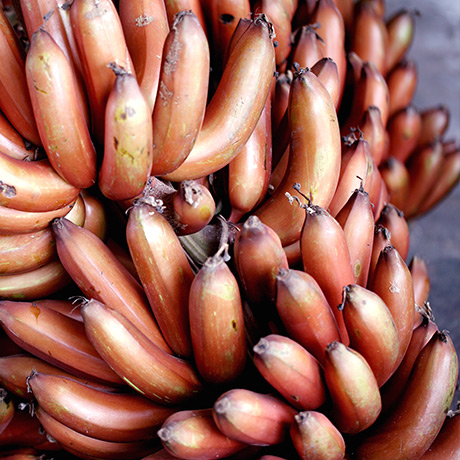
Red bananas are, like the name implies, red! They may also be pinkish or purple and have a creamy flesh that is pink or orange and sweeter than a typical yellow banana.
Red bananas can be stored at room temperature but if you want to speed up the ripening process, you can place them in a paper bag. When it comes to serving them, you can pair them with dairy products – a red banana sundae is a very tasty treat indeed! Red bananas are also excellent in pies, cakes, and even donuts.
In terms of nutrients, red bananas are an excellent source of vitamin B6, vitamin C, potassium, riboflavin, and magnesium.












